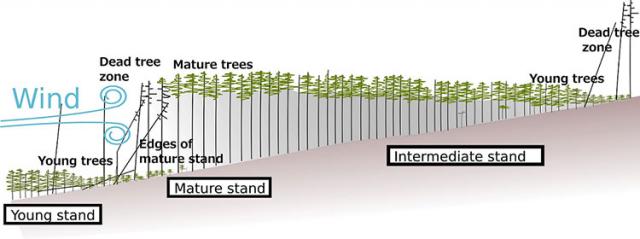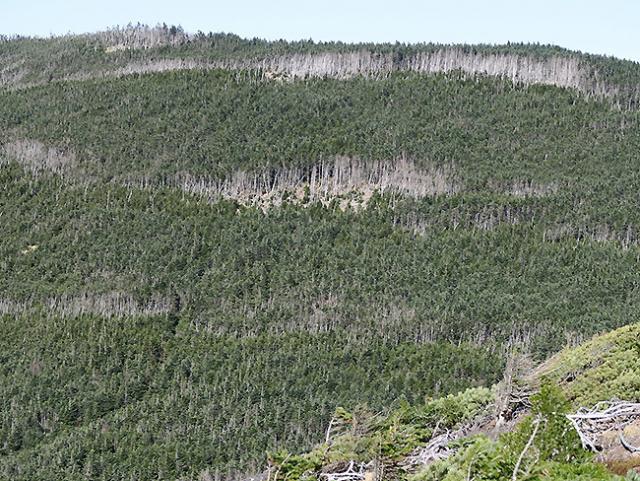Home > Research > Research Results > Research Results 2018 > Sixty Years are not enough for Wave-regeneration Forests to Recover: The Recovery Process after Typhoon Vera
Update:December 12, 2018
Main content starts here.
Sixty Years are not enough for Wave-regeneration Forests to Recover: The Recovery Process after Typhoon Vera
| Article title |
Changes of above- and below-ground biomass forty-three years after a typhoon disturbance in a subalpine wave regeneration forest on Mt. Shimagare |
|---|---|
| Author (affiliation) |
Kojiro IWAMOTO (a)、Shin UGAW (b)、Masatake G. ARAKI (c)、Daisuke KABEYA (c)、Moriyoshi ISHIZUKA (d)、Takuya KAJIMOTO (e) (a) Tama Forest Science Garden, FFPRI, Hachioji, Tokyo, Japan. (c) Department of Plant Ecology, FFPRI, Tsukuba, Ibaraki Japan. (d) Japan International Forestry Promotion and Cooperation Center,Bunkyo-ku, Tokyo, Japan. (e) Tohoku Research Center, FFPRI, Morioka, Iwate, Japan. |
| Publication Journal |
Bulletin of FFPRI, Vol.17 No.2 (No.446), 117 – 131, June 2018 DOI:10.20756/ffpri.17.2_117( External link ) |
| Content introduction |
Even when damaged by events such as typhoons, forests have an inherent ability to restore themselves to their original state. However, after a large-scale disturbance, that recovery is significantly delayed, and in some cases, the forest is unable to return to its former state. This study examined the recovery process of an area of forest in the subalpine zone of Kita-Yatsugatake, Nagano Prefecture, after it incurred damaged during Typhoon “Vera” (the Isewan Typhoon) in 1959, focusing on tree growth and biomass dynamics. The survey was conducted in a “wave-regeneration forest.” In a wave-regeneration forest, visible stripes of dead trees (dead tree zones; see Photo 1) generated by wind-induced disturbance gradually move up the slope . This results in a pattern wherein the stripes are interposed by forested areas that run from mature trees at the leading edge into shorter young trees further back (Figure 1). According to an analysis of data including old aerial photographs, it was thought that, when the typhoon hit about 60 years ago, primarily tall trees of over eight meters incurred wind damage, and a new dead tree zone—several tens of meters wide—was formed. Therefore, as a next step, three study areas were established—a mature stand where the oldest trees are currently located (60-year-old trees), a young stand (20-year-old trees), and an intermediate stand where trees have regenerated from the former dead tree zone (40-year-old trees)—and the growth process of individual trees was estimated along with biomass of stands. The results showed that, in the intermediate stand, the growth of individual trees after the damage was quicker than in the mature stand, and biomass had already been restored to pre-damage levels; however, in the mature stand, trees had begun to die, and the biomass recovery process was delayed, suggesting that the growth process of this area is different from other wave-regeneration forests. The findings suggest that if damages expand following increasing size of typhoons in the future due to climate change, this may also have a significant effect on the regeneration and distribution of subalpine forests.
In the wave-regeneration forest of Kita-Yatsugatake, Nagano Prefecture, dead trees are arranged in band-shaped patterns. Although 60 years have passed since Typhoon Vera, the forest has not fully recovered from the typhoon damage. |
Copyright © Forest Research and Management Organization. All rights reserved.


